by Mary Bailey
Trudy Heiss came to the Okanagan over 40 years ago with her husband George and went on to build one of the largest family estates in the valley. Sandra Oldfield is a transplanted Californian who seriously considered moving back to the sunny state after the disastrous 1999 vintage. Senka Tennant, creator of the iconic red Nota Bene, now makes whites on the Naramata Bench. Severine Pinte’s love of Syrah and the possibilities of the southern Okanagan led her to the Black Sage bench.
Their stories have created the narrative and continue to shape our experience of wine in the Okanagan.
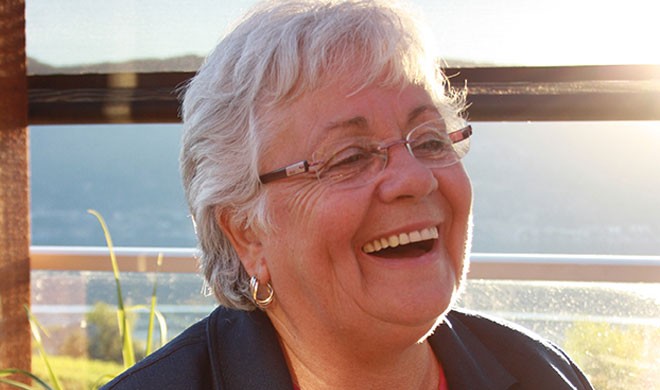
Trudy Heiss, Gray Monk Estate Winery
Photo Amanda LeNeve
“Today I’m picking out a new door for the restaurant; we wore the other one out,” says Trudy Heiss from the phone in the office she shares with her husband George.
George and Trudy own and operate Gray Monk Estate Winery, 45 acres of prime vineyard land north of Kelowna overlooking Okanagan Lake. The Heiss’ started planting vinifera in 1972, including Canada’s first Pinot Gris planted in 1976. In 1980 they made 170 cases of wine in their garage and sold their first bottle of wine in 1982 for $6.95.
“This year we’ll make 103,000 cases, not our choice,” says Trudy. “The grapes had 50 per cent more juice — it does happen once in awhile. We were scrambling, everybody was. My guys were looking at my swimming pool for fermentation, suggesting that George and Harry do cannonballs as the punch down.
“Normally we make 70-80,000 cases so this was a big push for us. Everybody was in the same boat.
“In the beginning when we did the Becker project to figure out what could grow here we had so many different rootstocks and clones. They made some good wines. But it became too much so we pulled out many of the experimental vines. We kept the Kerner, Ehrenfelser, Pinot Gris of course, Auxerrois, Siegerrebe. We also buy grapes throughout the valley, and we grow reds and Orange Muscat down south.
“We planted them all. I’m a bit more arms length now. Instead of being on the tractor, which was my favourite job, knowing what every vine was doing; now it’s mostly sales and marketing.
“We have 40 employees plus the restaurant. This year for the first time, we’ll be able to supply the Ontario market with 3,000 cases of our Gris. We had no idea how big this thing was going to get. I’m 74, George is 75; I suppose in 20 years we won’t have to worry about it at all.”
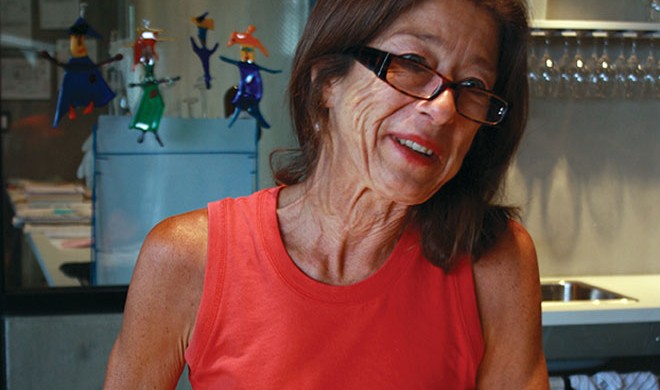
Senka Tennant, Terravista Vineyards
Photo Amanda LeNeve
“Oh, I thought you were coming over, I just put some Figaro in the fridge.” Sad for me that I’m on the phone, and not drinking wine with Senka Tennant.
“I started it with my husband,” says Senka, referring to Black Hills Estate, home of Nota Bene. “The first vintage at Black Hills was 1999, we started in 1996, almost 20 years ago, such a long time. We just kind of plodded along instinctually. I have always listened to that.
“My husband had been in construction. We moved to the Okanagan and I got the itch to go back to school to take oenology. We were the second paying students in the program at Okanagan College; initially the course was sponsored by UI because they wanted to increase employment in the valley. Lynn Bremmer, the biochemist at Sumac Ridge at the time, taught the lab course.
She was awesome and very precise, and had everybody shaking in their booties. I did a crush with Harry (McWatters). He said he hired me because I was impassioned. It’s nice to go to a meeting and have this familiarity with people from that time.”
Now Senka makes white wine high on the Naramata Bench near Penticton.
“The interesting thing about the Naramata Bench is that the land is so varied, based on the way the glacier moved. At Black Hills we were on the beach, the sandy loam of the Black Sage Bench. We don’t have as much frost here as we’re closer to the lake. Black Sage could get cold.”
When I asked Senka a few years ago why there were no plans for red wine at Terravista, she replied that they wanted to be able to go away in the winter, and reds need more attention through the winter than whites. A trip to Spain got them excited about Albarino and Verdejo (even if finding the vines to plant proved to be a bit of a nightmare).
“It’s our fifth vintage of Figaro (Rousanne, Marsanne and Viognier) fourth of Fandango (Albarino and Verdejo blend) third for Viognier, and first vintage for a single varietal Albarino.
“Now we focus on food pairing. These wines are made to go beautifully with food.
“Sometimes people are astonished we don’t make a red. I go ’round the mulberry bush on that; I would make a red again if I found the right fruit. At my age it’s all serendipitous.”
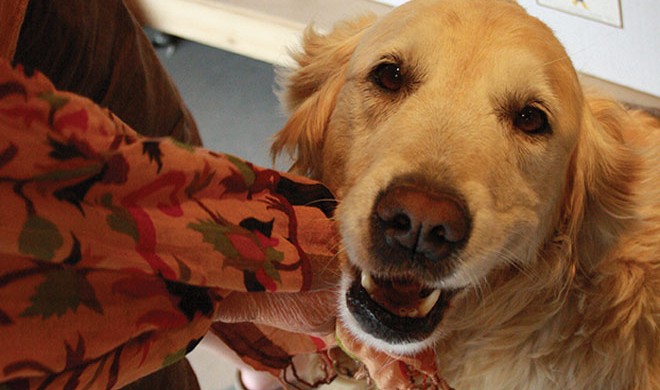
Photo Amanda LeNeve
Sandra Oldfield is the CEO of Tinhorn Creek Vineyards in the south Okanagan and a leading light behind the new Golden Mile sub-appellation. She was the winemaker at Tinhorn up until last year.
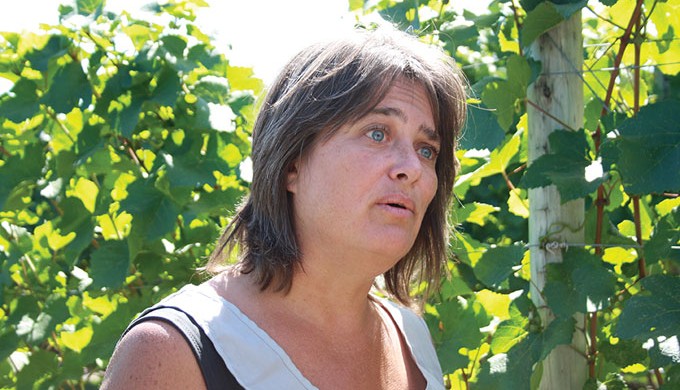
Sandra Oldfield, Tinhorn Creek Vineyards
Photo Amanda LeNeve
“When we first started we asked tons and tons of questions of our neighbours. We knew pretty quickly that this was farming, but we were bridging a gap. We had been to school but didn’t have the experience, and they had learned by doing. Some people didn’t want to share, some did. Eric von Krosigk was always someone I could pick up the phone and talk to. Tillman Hainle, same. My door is always open, I love it when new wineries call.”
The Golden Mile sub-appellation is a first for the valley. It defines an area with a particular type of soil. It doesn’t dictate grape varieties, production methods, yields or any other sort of control found in old world appellation systems. Rather, it’s based on geology.
“The sub-app is forward looking — it will define the valley over the next 20 years,” says Sandra. “It took six years but now that the groundwork is laid it’ll be interesting to see if other areas go ahead with applications. We actually don’t grow a lot of grapes within it. All of our reds are grown on the other bench.
“I run the business. My title has evolved from winemaker/owner, which people understood, to CEO, which people don’t get. I have been asked, in the grocery store, ‘how does it feel to be a female president’ and, ‘what do you do’, or, ‘are you vacationing now’?
“Would they ask a man that? Maybe it’s because people still see me as the winemaker. If I just called myself proprietor, maybe people would know what I was talking about.
“There are a decent number of female winemakers now, but as CEO, I’m back to being the only female in the room.
“The biggest thing for me was adopting our daughter Melanie. I have flexibility at Tinhorn; I still see her to the school bus every other day. We have an interesting workforce, aging people with aging parents and young people with kids, and now I’m more understanding of our employees’ need for balance.
Melody has her own little life. I’ll say it’s harvest, and she’ll say; ‘really?’
“I’m OK with that. I found wine on my own; I want her to find what she loves on her own.”
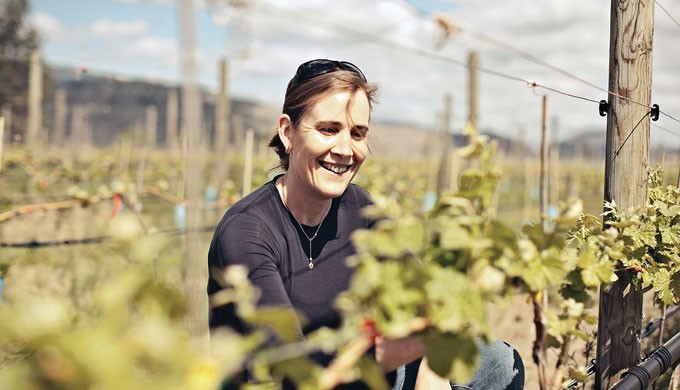
Severine Pinte, Le Vieux Pin
Photo Courtesy courtesy Le Vieux Pin
Severine Pinte has managed vineyards and made wine on three continents, in her native France (Bordeaux, Gaillac and the Languedoc) Australia and in Canada. That depth of experience coupled with a masters in viticulture and oenology from ENSAM (Ecole National Superior Agronomic of Montpellier) makes Severine a force to be reckoned with.
In 2010 Severine became the winemaker and viticulturalist for Le Vieux Pin along with its sister winery La Stella.
“The climate in the south Okanagan can be challenging but the terroir is exceptional. The hot days and cool nights are perfect for grapes. We start first in the vineyard; grow the grapes, then make the wine. I suppose I think that way because back in France we think grapes first.”
“When I first came here, people saw the grapes as just a production tool, a way of making money. They were motivated more by production, not the quality of fruit. Now I find that more winemakers are involved in the vineyard.”
Any regrets?
“No,” she says, then reconsiders. “Not buying a piece of land when I first came in 1996 (during an internship with UBC studying wet zones and beaver damage). I could have had my own vineyard.
“There is really nothing I would do differently. Because it’s a physical job, people tend to say women can’t do it, and there have been times in my career when I have worked twice as hard and was not paid more. Now, here, I have achieved quite a bit, I am a managing partner, and I am making the wines.”
I asked Severine if she thought it was important for more women to be in viticulture and wine.
“More men are applying for the jobs, but perhaps women have a better sense of smell. I have found in general that women are more organized—we already do so much multitasking as mums. Winemaking is 80 per cent organization. That said, there are a lot of men making great wines.”
As harvest progresses, Severine is in the vineyards, tasting and testing grapes daily. Le Vieux Pin is best known for a trio of top-notch Syrah. For lovers of Syrah it doesn’t get much better than this.
“The Classique is bold, spicy; Cuvee Violette has more flowers, with super silky tannins; and the Equinoxe expresses elegance and power. Each block gives us different fruit; I adapt technique to the grapes—I won’t extract as much or the cold soak might be longer.
“What you are tasting is the site,” says Severine. “The wines show what the vineyard gives.”